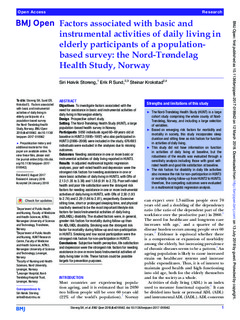| dc.contributor.author | Storeng, Siri Høivik | |
| dc.contributor.author | Sund, Erik | |
| dc.contributor.author | Krokstad, Steinar | |
| dc.date.accessioned | 2018-08-10T12:40:43Z | |
| dc.date.available | 2018-08-10T12:40:43Z | |
| dc.date.created | 2018-05-24T11:41:25Z | |
| dc.date.issued | 2018 | |
| dc.identifier.citation | BMJ Open. 2018, 8 (3), 1-10. | nb_NO |
| dc.identifier.issn | 2044-6055 | |
| dc.identifier.uri | http://hdl.handle.net/11250/2557562 | |
| dc.description.abstract | Objectives
To investigate factors associated with the need for assistance in basic and instrumental activities of daily living in Norwegian elderly.
Design
Prospective cohort study.
Setting
The Nord-Trøndelag Health Study (HUNT), a large population-based health survey in Norway.
Participants
5050 individuals aged 60–69 years old at baseline in HUNT2 (1995–1997) who also participated in HUNT3 (2006–2008) were included in the study. 676/693 individuals were excluded in the analyses due to missing outcomes.
Outcomes
Needing assistance in one or more basic or instrumental activities of daily living reported in HUNT3.
Results
In adjusted multinomial logistic regression analyses, poor self-rated health and depression were the strongest risk factors for needing assistance in one or more basic activities of daily living in HUNT3, with ORs of 2.13 (1.35 to 3.38) and 1.58 (0.91 to 2.73). Poor self-rated health and poor life satisfaction were the strongest risk factors for needing assistance in one or more instrumental activities of daily living in HUNT3, with ORs of 2.30 (1.93 to 2.74) and 2.29 (1.86 to 2.81), respectively. Excessive sitting time, short or prolonged sleeping time, and physical inactivity seemed to be the most important lifestyle risk factors for basic/instrumental activities of daily living (ADL/IADL) disability. The studied factors were, in general, greater risk factors for mortality during follow-up than for ADL/IADL disability. Smoking was the strongest risk factor for mortality during follow-up and non-participation in HUNT3. Smoking and low social participation were the strongest risk factors for non-participation in HUNT3.
Conclusions
Subjective health perception, life satisfaction and depression were the strongest risk factors for needing assistance in one or more basic/instrumental activities of daily living later in life. These factors could be possible targets for prevention purposes. | nb_NO |
| dc.language.iso | eng | nb_NO |
| dc.publisher | BMJ Publishing Group | nb_NO |
| dc.rights | Navngivelse-Ikkekommersiell 4.0 Internasjonal | * |
| dc.rights.uri | http://creativecommons.org/licenses/by-nc/4.0/deed.no | * |
| dc.title | Factors associated with basic and instrumental activities of daily living in elderly participants of a population-based survey: The Nord-Trøndelag Health Study, Norway | nb_NO |
| dc.type | Journal article | nb_NO |
| dc.type | Peer reviewed | nb_NO |
| dc.description.version | publishedVersion | nb_NO |
| dc.source.pagenumber | 1-10 | nb_NO |
| dc.source.volume | 8 | nb_NO |
| dc.source.journal | BMJ Open | nb_NO |
| dc.source.issue | 3 | nb_NO |
| dc.identifier.doi | 10.1136/bmjopen-2017-018942 | |
| dc.identifier.cristin | 1586397 | |
| dc.description.localcode | This is an Open Access article distributed in accordance with the Creative Commons Attribution Non Commercial (CC BY-NC 4.0) | nb_NO |
| cristin.unitcode | 194,65,20,0 | |
| cristin.unitcode | 194,65,20,15 | |
| cristin.unitname | Institutt for samfunnsmedisin og sykepleie | |
| cristin.unitname | Helseundersøkelsen i Nord-Trøndelag | |
| cristin.ispublished | true | |
| cristin.fulltext | original | |
| cristin.qualitycode | 1 | |

